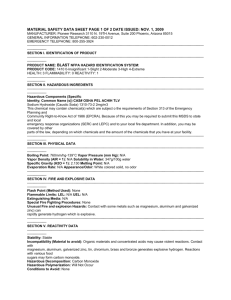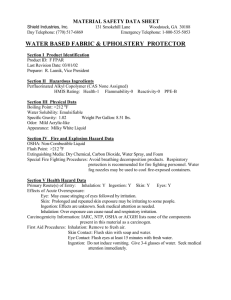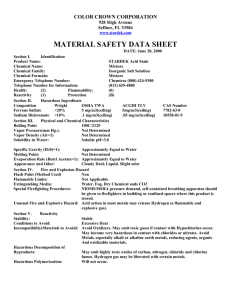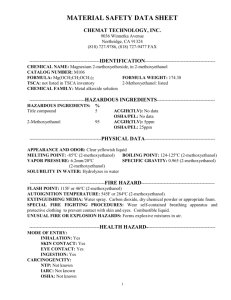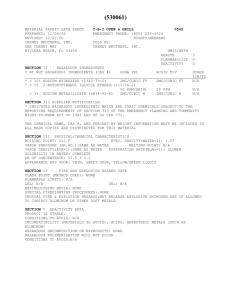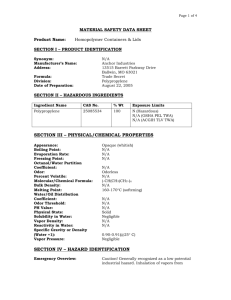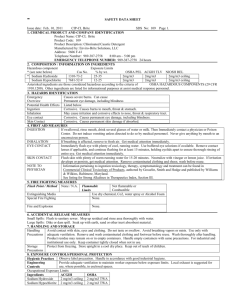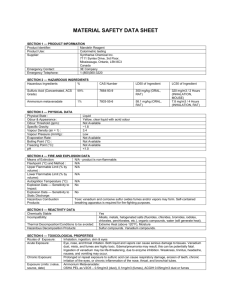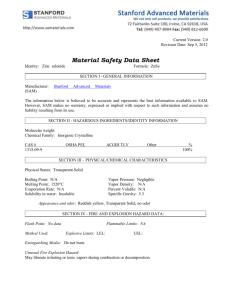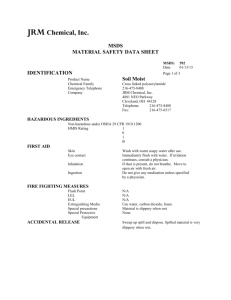Metro-Gold Page 1 of 2 Material Safety Data Sheet Quick Identifier
advertisement
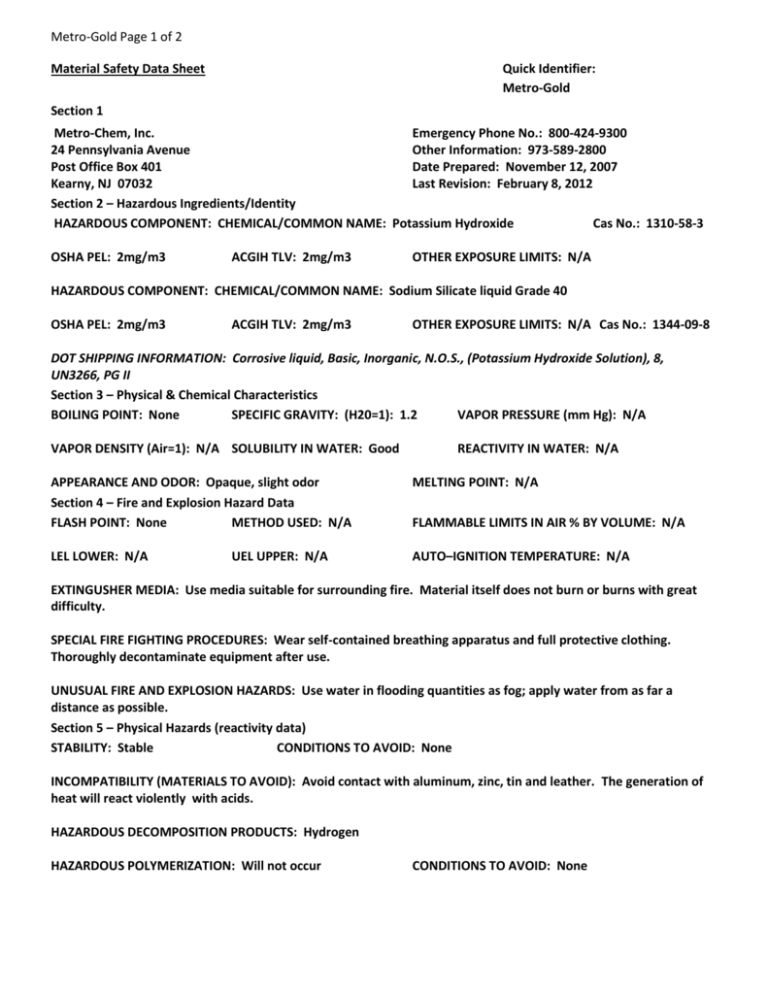
Metro-Gold Page 1 of 2 Material Safety Data Sheet Quick Identifier: Metro-Gold Section 1 Metro-Chem, Inc. Emergency Phone No.: 800-424-9300 24 Pennsylvania Avenue Other Information: 973-589-2800 Post Office Box 401 Date Prepared: November 12, 2007 Kearny, NJ 07032 Last Revision: February 8, 2012 Section 2 – Hazardous Ingredients/Identity HAZARDOUS COMPONENT: CHEMICAL/COMMON NAME: Potassium Hydroxide Cas No.: 1310-58-3 OSHA PEL: 2mg/m3 ACGIH TLV: 2mg/m3 OTHER EXPOSURE LIMITS: N/A HAZARDOUS COMPONENT: CHEMICAL/COMMON NAME: Sodium Silicate liquid Grade 40 OSHA PEL: 2mg/m3 ACGIH TLV: 2mg/m3 OTHER EXPOSURE LIMITS: N/A Cas No.: 1344-09-8 DOT SHIPPING INFORMATION: Corrosive liquid, Basic, Inorganic, N.O.S., (Potassium Hydroxide Solution), 8, UN3266, PG II Section 3 – Physical & Chemical Characteristics BOILING POINT: None SPECIFIC GRAVITY: (H20=1): 1.2 VAPOR PRESSURE (mm Hg): N/A VAPOR DENSITY (Air=1): N/A SOLUBILITY IN WATER: Good REACTIVITY IN WATER: N/A APPEARANCE AND ODOR: Opaque, slight odor Section 4 – Fire and Explosion Hazard Data FLASH POINT: None METHOD USED: N/A MELTING POINT: N/A LEL LOWER: N/A AUTO–IGNITION TEMPERATURE: N/A UEL UPPER: N/A FLAMMABLE LIMITS IN AIR % BY VOLUME: N/A EXTINGUSHER MEDIA: Use media suitable for surrounding fire. Material itself does not burn or burns with great difficulty. SPECIAL FIRE FIGHTING PROCEDURES: Wear self-contained breathing apparatus and full protective clothing. Thoroughly decontaminate equipment after use. UNUSUAL FIRE AND EXPLOSION HAZARDS: Use water in flooding quantities as fog; apply water from as far a distance as possible. Section 5 – Physical Hazards (reactivity data) STABILITY: Stable CONDITIONS TO AVOID: None INCOMPATIBILITY (MATERIALS TO AVOID): Avoid contact with aluminum, zinc, tin and leather. The generation of heat will react violently with acids. HAZARDOUS DECOMPOSITION PRODUCTS: Hydrogen HAZARDOUS POLYMERIZATION: Will not occur CONDITIONS TO AVOID: None Metro-Gold Page 2 of 2 Section 6 – Health Hazards 1. ACUTE (Immediate) TOXICITY: SKIN: Alkali solution exerts a marked corrosive action on those tissues with which it comes in contact, resulting in burns, frequently deep ulceration and ultimate scarring. Even diluted solutions will cause burns on prolonged contact. Multiple small burns may result from exposure to Metro-Gold mist. Contact with MetroGold solution does not always cause an immediate burning sensation. If there is suspected contact, the skin should be flushed with water immediately. EYES: Contact with eyes very rapidly can cause severe damage to the eye. INGESTION: Results in severe damage to mucous membranes and to underlying tissues with which contact is made. Perforation of these tissues may follow; severe and extensive scar formation may occur. Death may occur if penetration to vital areas occurs. INHALATION: Inhalation of Metro-Gold mist may cause damage to the upper respiratory tract and lungs. Effects will vary, depending on the severity of the exposure, from mild irritation of the nasal membranes to severe pnuemonitis. 2. CHRONIC (Delayed Effect): Chronic local exposure to diluted solutions may cause primary dermatitis and area of superficial skin destruction. Similarly, chronic inhalation of Metro-Gold mist may result in varying degrees of irritation of the respiratory tract tissue. MEDICAL CONDITIONS GENERALLY AGRAVATED BY EXPOSURE: Respiratory conditions. CHEMICAL LISTED AS CARCNOGEN OR POTENTIAL CARCINOGEN: NATIONAL TOXICOLOGY PROGRAM: No I.A.R.C MONOGRAPHS: No OSHA: No EMERGENCY AND FIRST AID PROCEDURES: INHALATION: ROUTES OF ENTRY Remove to fresh air. If required, give mouth-to-mouth resuscitation. Get immediate medical Attention. EYES: Flush with copious water at least 15 minutes. Get immediate medical attention. SKIN: Wash off with copious water. Remove contaminated clothing and do not re-use until laundered. For severe burns, get medical attention. INGESTION: DO NOT induce vomiting. Feed milk if available, otherwise, use large quantities of water. Get immediate medical attention. Section 7 – Precautions and Spill/Leak Procedures PRECAUTIONS TO BE TAKEN IN HANDLING AND STORAGE: Keep container closed. Avoid contact with strong acids to prevent violent explosive reactions. Do not allow water to get into container because of violent reaction. OTHER PRECAUTIONS: Separate from acids, metals, organic peroxides and ignitable materials. STEPS TO BE TAKEN IN CASE MATERIAL IS RELEASED OR SPILLED: CAUTION: Spill area will be slippery. If the drum has been punctured dike area with sand or earth and pump remaining product into a salvage tank. SPILL AREA: Flush spill area with water and neutralize washings with mineral acids. WASTE DISPOSAL METHODS (Consult federal, state and local regulations): Carefully dilute with large quantities of water, neutralize with mineral acids, and discharge slowly to sewer if allowed by local, state and federal regulations. Otherwise, place in a closed container, label and remove to an approved chemical waste disposal area. People performing this work should wear adequate personal protective equipment and clothing. Section 8 – Special Protection Information/Control Measures RESPIRATORY PROTECTION (Specify Type): Use of NIOSH approved respiratory equipment is required. VENTILATION: LOCAL EXHAUST: Adequate exhaust MECHANICAL: N/A SPECIAL: N/A OTHER: N/A PROTECTION GLOVES: Rubber or chemical resistant, required. EYE PROTECTION: Safety goggles, glasses or face shield required. OTHER PROTECTIVE CLOTHING OR EQUIPMENT: Chemical resistant shoes and/or apron recommended. WORK/HYGENIC PRACTICES: Eyewash stations nearby required and safety showers should be handy. We believe the information contained herein is true; however, no warranties, expressed or implied, are made or intended herein with respect to such information.
